人教版英语七年级上册常用方位介词和短语(巩固练习)
- 格式:doc
- 大小:34.00 KB
- 文档页数:3

巩固练习】1 •把下列词组翻译成英语。
1. ___________________ 在沙发上2. 在桌子底下____________3. 在你的背包里____________4. 在抽屉里__________5. __________________________ 在教室(外部)前面II .单项选则。
1. Your computer is _____ to the door.A. behindB. onC. inD. next2 The map is ___ the wall ___ our classroom.A. on; onB. of; onC. on; atD. on; of3 Look! The window is ___ the wall and the picture is ____ the wall.A. on; onB. in; inC. in; onD. on; in4-Where is my ball? I can ' t see it. Look! It ' s ___________ the door.A. onB. inC. atD. behind5. Sally is very happy. There is a big smile _____ her face.A. onB. toC. inD. at6. My father is ill (生病), He is _ .A. in bedB. in the bedC. on bedD. on the bed7. There is a map of China _____ the wall in the classroom.A. inB. onC. underD. at8. There are three windows ____ the wall.A.inB. onC. atD. to9. There are many oranges ____ the tree. A bird _____ the tree is eating an orange.A. in; onB. on; onC. in; inD. on; in10. -What time do you usually go to bed?-I usually go to bed _____ 11:00.A. inB. onC. atD. for11. We can see _____ old bike _____ the tree.A. a; underB. the; atC. an; inD. an; under12. My hats and coats are _____ .A. on the bedB. under deskC. in roomD. under the my bed13. ___________________ He put up a map ________________________ the back wall because there was a hole it.A. on; onB. at; inC. on; inD. on; at14. ____________ Don't read the sun.A. atB. underC. withD. in15. The boat is passing___ the bridge.A. throughB. belowC. underD. acrossIII. 用适当的介词填空。
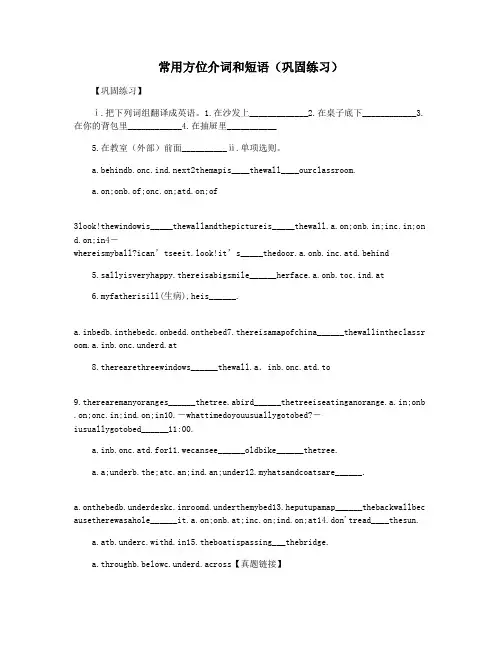
常用方位介词和短语(巩固练习)【巩固练习】ⅰ.把下列词组翻译成英语。
1.在沙发上_____________2.在桌子底下____________3.在你的背包里____________4.在抽屉里___________5.在教室(外部)前面__________ⅱ.单项选则。
a.behindb.onc.ind.next2themapis____thewall____ourclassroom.a.on;onb.of;onc.on;atd.on;of3look!thewindowis_____thewallandthepictureis_____thewall.a.on;onb.in;inc.in;on d.on;in4-whereismyball?ican’tseeit.look!it’s_____thedoor.a.onb.inc.atd.behind5.sallyisveryhappy.thereisabigsmile______herface.a.onb.toc.ind.at6.myfatherisill(生病),heis______.a.inbedb.inthebedc.onbedd.onthebed7.thereisamapofchina______thewallintheclassr oom.a.inb.onc.underd.at8.therearethreewindows______thewall.a.inb.onc.atd.to9.therearemanyoranges______thetree.abird______thetreeiseatinganorange.a.in;onb .on;onc.in;ind.on;in10.-whattimedoyouusuallygotobed?-iusuallygotobed______11:00.a.inb.onc.atd.for11.wecansee______oldbike______thetree.a.a;underb.the;atc.an;ind.an;under12.myhatsandcoatsare______.a.onthebedb.underdeskc.inroomd.underthemybed13.heputupamap______thebackwallbec ausetherewasahole______it.a.on;onb.at;inc.on;ind.on;at14.don'tread____thesun.a.atb.underc.withd.in15.theboatispassing___thebridge.a.throughb.belowc.underd.across【真题链接】1.―mygreenringisintheroom.whataboutyours?(2021武汉江汉期中)―_________.a.it’sredb.it’sonthetablec.it’salice’s2.thereare30classrooms____________ourschool.mineis_____________thesecondfloor.(2021江苏江阴期中)a.on;inb.in;inc.in;ond.on;on3.ihaveafriendandmyfriendis________china.(2021杭州期中)a.inb.atc.ond.underiii.用适度的介词填空题。
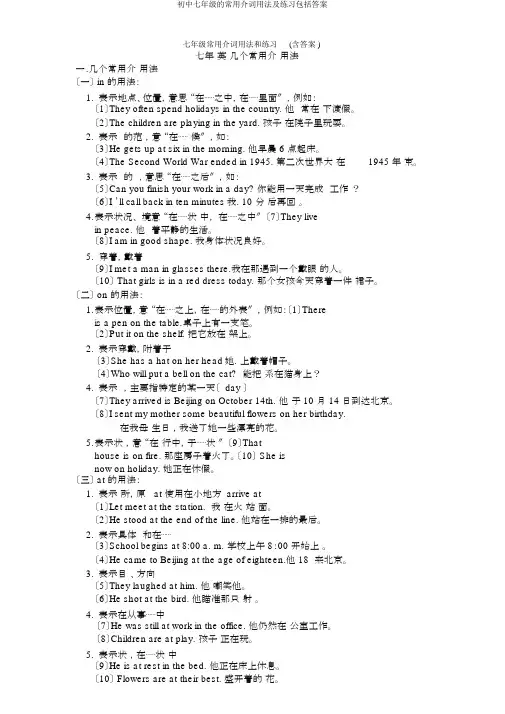
七年级常用介词用法和练习(含答案 )七年英几个常用介用法一.几个常用介用法〔一〕 in 的用法:1.表示地点、位置,意思“在⋯⋯之中,在⋯⋯里面〞,例如:〔1〕They often spend holidays in the country. 他常在下渡假。
〔2〕The children are playing in the yard. 孩子在院子里玩耍。
2.表示的范,意“在⋯⋯候〞,如:〔3〕He gets up at six in the morning. 他早晨 6 点起床。
〔4〕The Second World War ended in 1945. 第二次世界大在1945 年束。
3.表示的,意思“在⋯⋯之后〞,如:〔5〕Can you finish your work in a day? 你能用一天完成工作?〔6〕I ’ll call back in ten minutes我. 10 分后再回。
4.表示状况、境意“在⋯⋯状中,在⋯⋯之中〞〔7〕They livein peace. 他着平静的生活。
〔8〕I am in good shape. 我身体状况良好。
5.穿着,戴着〔9〕I met a man in glasses there.我在那遇到一个戴眼的人。
〔10〕 That girls is in a red dress today. 那个女孩今天穿着一件裙子。
〔二〕 on 的用法:1.表示位置,意“在⋯⋯之上,在⋯⋯的外表〞,例如:〔1〕Thereis a pen on the table.桌子上有一支笔。
〔2〕Put it on the shelf. 把它放在架上。
2.表示穿戴,附着于〔3〕She has a hat on her head她.上戴着帽子。
〔4〕Who will put a bell on the cat? 能把系在猫身上?4.表示,主要指特定的某一天〔 day 〕〔7〕They arrived is Beijing on October 14th. 他于 10 月 14 日到达北京。

Unit4 方位介词用法专练一、单项选择。
1. —Where is your bag, Eric?—It’s _____ the floor.A. onB. ofC. toD. with2. 一______ is your notebook?—It’s in the bookcase.A. WhatB. HowC. WhoD. Where3. 一Is my model plane _____ the chair?—I can’t see itA. underB. forC. ofD. in4. —______ your books?—They are in my schoolbag.A. What’sB. What areC. Where isD. Where are5. There are two windows _______ the right wall. There is one beautiful picture _______ the left wall.A. in; onB. in; inC. on; onD. on; in6. There is a light ______ his head.A. onB. inC. aboveD. under7. The U.S. is _____ the west of Canada.A. onB. /C. toD. in二、根据汉语意思完成句子。
1. 我的橡皮在书桌上。
My eraser ______ ______ ______.2. 她的尺子在椅子下面。
Her ruler is ______ ______ ______.3. 收音机在你祖父母的房间里。
The radio is ______ ______ ______ ______.参考答案及解析一、1. A 题干问句询问物体的位置,on the floor “在地板上”。
2. D what“什么”;how“怎样”;who“谁”;where“哪里”。
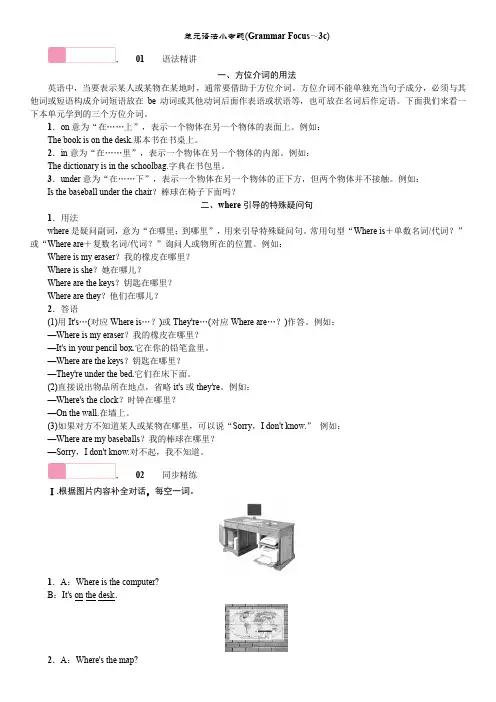
单元语法小专题(Grammar Focus~3c),01语法精讲一、方位介词的用法英语中,当要表示某人或某物在某地时,通常要借助于方位介词。
方位介词不能单独充当句子成分,必须与其他词或短语构成介词短语放在be动词或其他动词后面作表语或状语等,也可放在名词后作定语。
下面我们来看一下本单元学到的三个方位介词。
1.on意为“在……上”,表示一个物体在另一个物体的表面上。
例如:The book is on the desk.那本书在书桌上。
2.in意为“在……里”,表示一个物体在另一个物体的内部。
例如:The dictionary is in the schoolbag.字典在书包里。
3.under意为“在……下”,表示一个物体在另一个物体的正下方,但两个物体并不接触。
例如:Is the baseball under the chair?棒球在椅子下面吗?二、where引导的特殊疑问句1.用法where是疑问副词,意为“在哪里;到哪里”,用来引导特殊疑问句。
常用句型“Where is+单数名词/代词?”或“Where are+复数名词/代词?”询问人或物所在的位置。
例如:Where is my eraser?我的橡皮在哪里?Where is she?她在哪儿?Where are the keys?钥匙在哪里?Where are they?他们在哪儿?2.答语(1)用It's…(对应Where is…?)或They're…(对应Where are…?)作答。
例如:—Where is my eraser?我的橡皮在哪里?—It's in your pencil box.它在你的铅笔盒里。
—Where are the keys?钥匙在哪里?—They're under the bed.它们在床下面。
(2)直接说出物品所在地点,省略it's或they're。
例如:—Where's the clock?时钟在哪里?—On the wall.在墙上。
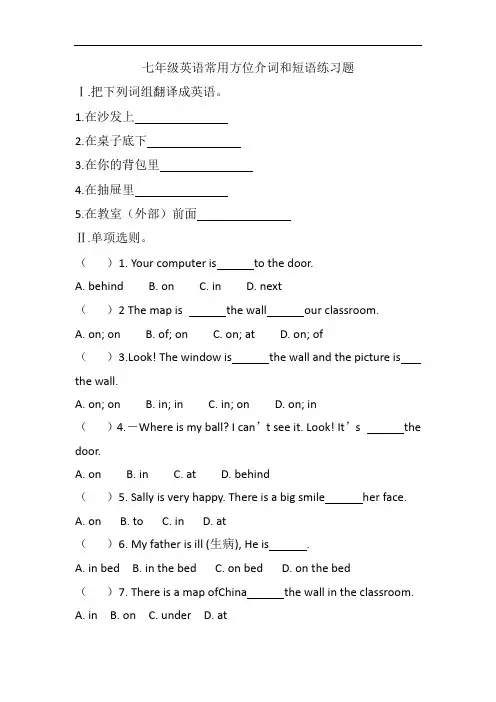
七年级英语常用方位介词和短语练习题Ⅰ.把下列词组翻译成英语。
1.在沙发上2.在桌子底下3.在你的背包里4.在抽屉里5.在教室(外部)前面Ⅱ.单项选则。
()1. Your computer is to the door.A. behindB. onC. inD. next()2 The map is the wall our classroom.A. on; onB. of; onC. on; atD. on; of()3.Look! The window is the wall and the picture is the wall.A. on; onB. in; inC. in; onD. on; in()4.-Where is my ball? I can’t see it. Look! It’s the door.A. onB. inC. atD. behind()5. Sally is very happy. There is a big smile her face. A. on B. to C. in D. at()6. My father is ill (生病), He is .A. in bedB. in the bedC. on bedD. on the bed()7. There is a map ofChina the wall in the classroom.A. inB. onC. underD. at()8. There are three windows the wall.A.in B. on C. at D. to()9. There are many oranges the tree. A birdthe tree is eating an orange.A. in; onB. on; onC. in; inD. on; in()10. ——What time do you usually go to bed?——I usually go to bed 11:00.A. inB. onC. atD. for()11. We can see old bike the tree.A. a; underB. the; atC. an; inD. an; under()12. My hats and coats are .A. on the bedB. under deskC. in roomD. under the my bed ()13. He put up a map the back wall because there was a hole it.A. on; onB. at; inC. on; inD. on; at()14. Don't read the sun.A. atB. underC. withD. in()15. The boat is passing the bridge.A. throughB. belowC. underD. across真题链接()1. ——My green ring is in the room. What about yours?——.A. It’s redB. It’s on the tableC. It’s Alice’s()2. There are 30 classrooms our school. Mine isthe second floor.A. on; inB. in; inC. in; onD. on; on()3. I have a friend and my friend is China.A. inB. atC. onD. underIII. 用适当的介词填空。

常用方位介词和短语巩固练习IMB standardization office【IMB 5AB- IMBK 08- IMB 2C】【巩固练习】Ⅰ.把下列词组翻译成英语。
1.在沙发上_____________2.在桌子底下____________3.在你的背包里____________4.在抽屉里___________5.在教室(外部)前面__________Ⅱ.单项选则。
.2Themapis____thewall____ourclassroom.;on;on;at;of3Look!Thewindowis_____thewallandthepictureis_____thewall.;on;in;on;in4-Whereismyball?Ican’!It’s_____thedoor.生病),Heis______.;;;;at'tread____thesun.【真题链接】1.—(2014武汉江汉期中)—_________.’sred’sonthetable’sAlice’s(2014江苏江阴期中);;;;on.(2014杭州期中)III.用适当的介词填空。
.(摘)theapples_____thetree?...Ⅳ.阅读短文回答问题。
Tom’sroomIt’【答案与解析】Ⅰ.把下列词组翻译成英语。
单项选择。
本句子是考查介词的用法,但是,介词behind,on,in的后面用冠词the和名词、冠词、介词短语,不和to连用,所以本句子是用形容词next和to连用表示“紧挨着、在旁边”的意思。
本句子用介词on和冠词the,名词wall构成介词短语表示“在墙上”的意思,后面用介词of构成名词所有格,表示所属关系,表示无生命的名词所有格的形式用of,而不用’s形式。
本句子是考查介词的用法,表示在某物的表面之上用介词on;表示在某物内部用介词in。
窗户是在墙的里面所以用介词in;画是贴在墙的表面上,与墙接触,所以用介词on。
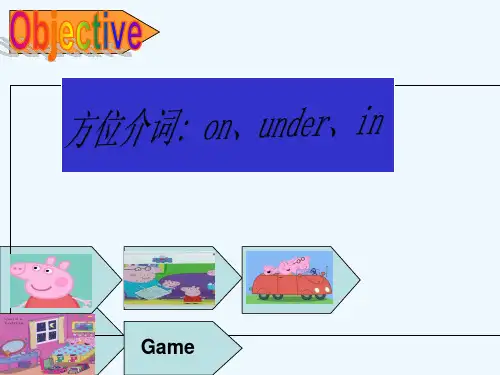
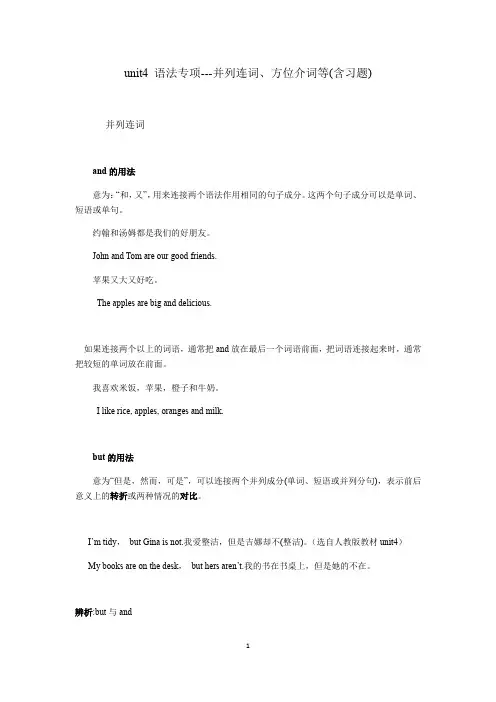
unit4 语法专项---并列连词、方位介词等(含习题)并列连词and的用法意为:“和,又”,用来连接两个语法作用相同的句子成分。
这两个句子成分可以是单词、短语或单句。
约翰和汤姆都是我们的好朋友。
John and Tom are our good friends.苹果又大又好吃。
The apples are big and delicious.如果连接两个以上的词语,通常把and放在最后一个词语前面,把词语连接起来时,通常把较短的单词放在前面。
我喜欢米饭,苹果,橙子和牛奶。
I like rice, apples, oranges and milk.but的用法意为“但是,然而,可是”,可以连接两个并列成分(单词、短语或并列分句),表示前后意义上的转折或两种情况的对比。
I’m tidy,but Gina is not.我爱整洁,但是吉娜却不(整洁)。
(选自人教版教材unit4)My books are on the desk,but hers aren’t.我的书在书桌上,但是她的不在。
辨析:but与and方位介词用法:常用于名词或代词前构成介词短语,用以表示主语所处的位置、地点等结构:方位介词(in/on/ under)+定冠词the或形容词性物主代词等+名词。
意义:on 意思是“在...上面”,通常指一个人或物在另一个物体的表面上,两者之间有接触面。
on the wal在墙上on the floor在(室内)地板上你的书在桌子上Your book is on the table.Where are my books?我的书在哪里?They’re on the sofa.它们在沙发上(选自人教版教材unit4)in表示“在……中;在……里面”,指在某个空间的内部。
在三班in Class3在教室in the classroomWhere’s my pencil box?我的铅笔盒在哪里?It’s in your schoolbag.它在你的书包里。
![[全]人教七年级英语上Unit4考点知识点解析+练习含答案](https://uimg.taocdn.com/99f3ff3bf705cc17552709e3.webp)
人教七年级英语上Unit4考点知识点全解析+练习含答案重点词汇解析1.where adv. 在哪里;到哪里【经典例句】Where are you?你在哪?【考点聚焦】where是特殊疑问词,用来引导特殊疑问句。
当我们不知道某东西在什么地方时,常用Where is/are...?来询问。
2.table n. 桌子【经典例句】There is a dog under the table.桌子下面有一条狗。
【考点聚焦】常用词组:at table在吃饭;at the table在桌旁【易混辨析】table与deskdesk表示"桌子"的意思。
指供读书、写字、办公用的桌子,一般带有抽屉。
例如:There are forty desks and chairs in the classroom. 教室里有四十张桌子和椅子。
There are two books on the desk.桌上有两本书。
table 意思是"桌子"。
侧重于指供吃饭、喝茶、游戏或其它用途的桌子,通常没有抽屉。
例如:Our football is under the table. 我们的足球在桌子底下。
Where is the table?桌子在哪儿?1.表示物体的方位,叫方位介词。
,in, on under, behind后面跟名词或名词词组构成介词短语on prep. 在……(紧贴着某物,有接触面)例如:on his desk"在他的书桌上",on the floor"在地板上",on the bed"在床上",on the wall"在墙上"等等。
under prep. 在……下面,例如:under my chair"在我的椅子下面",under the desk"在书桌下面",under kate's bed"在凯特的床下面"等。
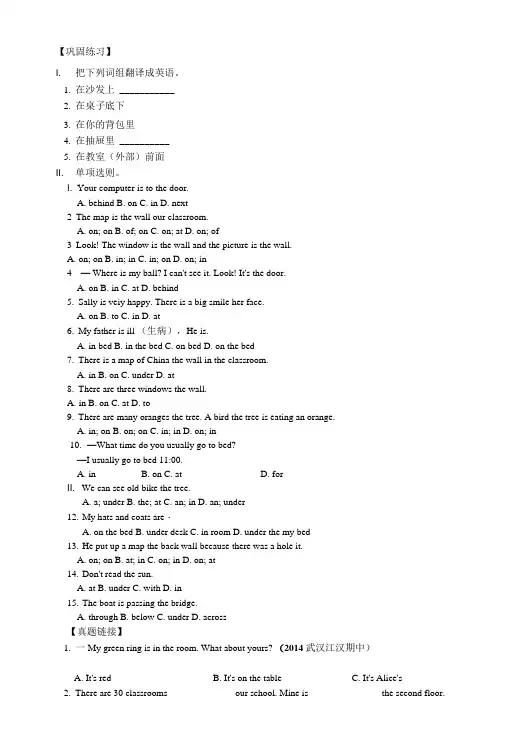
【巩固练习】I. 把下列词组翻译成英语。
1.在沙发上 ___________2.在桌子底下3.在你的背包里4.在抽屉里 __________5.在教室(外部)前面II. 单项选则。
I. Your computer is to the door.A. behindB. onC. inD. next2The map is the wall our classroom.A. on; onB. of; onC. on; atD. on; of3Look! The window is the wall and the picture is the wall.A. on; onB. in; inC. in; onD. on; in4— Where is my ball? I can't see it. Look! It's the door.A. onB. inC. atD. behind5.Sally is veiy happy. There is a big smile her face.A. onB. toC. inD. at6.My father is ill (生病),He is.A. in bedB. in the bedC. on bedD. on the bed7.There is a map of China the wall in the classroom.A. inB. onC. underD. at8.There are three windows the wall.A. inB. onC. atD. to9.There are many oranges the tree. A bird the tree is eating an orange.A. in; onB. on; onC. in; inD. on; in10.—What time do you usually go to bed?—I usually go to bed 11:00.A. inB. onC. atD. forII. We can see old bike the tree.A. a; underB. the; atC. an; inD. an; under12.My hats and coats are・A. on the bedB. under deskC. in roomD. under the my bed13.He put up a map the back wall because there was a hole it.A. on; onB. at; inC. on; inD. on; at14.Don't read the sun.A. atB. underC. withD. in15.The boat is passing the bridge.A. throughB. belowC. underD. across【真题链接】1.一My green ring is in the room. What about yours? (2014 武汉江汉期中)A. It's redB. It's on the tableC. It's Alice's2.There are 30 classrooms our school. Mine is the second floor.(2014江苏江阴期中)A. on; inB. in; inC. in; onD. on; on3.1 have a friend and my friend is China. (2014 杭州期中)A. inB.atC. onD. underIII. 用适当的介词填空。
人教版七年上册易混介用法及1、表示的介。
1)at 用于表示刻、的某一点at lunch 在午餐at dawn 在黎明at noon正午at that time 那at night 在夜at the moment此刻,目前at present目前at 9 o’clock 在九点at first 起初,开始的候at/on the weekend在周末at last 最后at the same time同at times 偶,有at the Spring Festival在春2)on 用于表示某天,某一天的上、下午on Monday 在周一on a cold night 在一个寒冷的夜晚on Tuesday morning在周二早上on a New Year’s Eve 在除夕on your birthday 在你生日那天on the morning of National Day 在国的上午on August 8,2008在 2008 年 8 月 8 日on the Children’s Day 在儿童那天on a fine morning 在一个晴朗的早晨on the morning of July first 在 7 月 1 日的早上3)in 用于表示月、季、年前。
in January在一月in the morning/afternoon/evening 在上午 /下午 /晚上in autumn 在秋季in the 21st century 在 21 世in 2013 在 2013 年in September,2012在 2012 年 9 月2、表示所、方向的介。
1)at 表示在某地点 (小地点 )at the school gate在学校口at the door 在at home在家at the airport 在机at the party 在聚会上at the bus stopz在公共汽站at the end of在⋯⋯末尾at my desk 在我的桌旁2)in 表示在某地(大地点);可表示在⋯⋯里。
七上方位介词练习题七上方位介词练习题方位介词是我们日常生活中经常使用的一类介词,它们用来表示物体或人在空间中的位置关系。
在英语中,方位介词有很多,如in、on、at、under、over等。
在学习方位介词的时候,我们经常会遇到一些练习题,下面就来看看几个七年级上册的方位介词练习题。
练习题一:选择正确的方位介词填空。
1. The book is ______ the table.2. The cat is ______ the chair.3. The ball is ______ the box.4. The bird is ______ the tree.5. The pen is ______ the pencil case.这是一个基础的方位介词练习题,通过选择正确的方位介词填空,来加深对方位介词的理解。
在这个练习题中,我们需要根据物体与物体之间的位置关系,选择合适的方位介词。
例如,在第一题中,我们需要选择in,因为书在桌子上。
练习题二:根据图片选择正确的方位介词填空。
这是一个更具挑战性的方位介词练习题,通过观察图片,选择正确的方位介词填空。
这种练习题可以帮助我们将方位介词的概念与实际场景联系起来,更好地理解方位介词的用法。
例如,当看到一张图片上有一个苹果在盘子上时,我们需要选择on作为正确的方位介词。
练习题三:写出合适的方位介词完成句子。
这是一个需要我们动手思考的方位介词练习题,通过写出合适的方位介词来完成句子。
这种练习题可以帮助我们巩固对方位介词的掌握,并提高我们的语言表达能力。
例如,当我们看到一句句子“Tom is ______ the bed.”时,我们需要根据Tom与床之间的位置关系,选择合适的方位介词填空。
练习题四:用方位介词描述图片中的场景。
这是一个需要我们运用方位介词进行描述的练习题,通过观察一张图片,用方位介词来描述图片中的场景。
这种练习题可以帮助我们提高语言表达能力,同时也加深对方位介词的理解。
表示地点的介词表示地点的介词表示地点的介词表示地点的介词in...on...behind...next to...near...over…under(1). in在……里面:The pencil is in the desk. 铅笔在课桌里。
(2). on在……上面:There are some apple on the tree. 树上有些苹果。
(3). under在……下面/正下方:What's under your desk? 你书桌底下是什么?(4). over在……正上方:There is a shelf over the table. 桌子上方有一个书架。
(5). above 在……斜上方:Raise your arms above your head.(6). below 在……斜下方:Her skirt came below her knees.(7).behind在……之后:There is a bike behind the tree. 树后有一辆自行车。
(8).next to在……旁边:There is a café next to the barber's. 理发店隔壁是一家咖啡馆。
(9).near在……附近:My bed is near the window. 我的床在窗户旁。
(10).by 在……旁:He was sitting by the window . 第一组:over, above和on的用法1)over指在…的正上方,表示垂直在上。
如: There is a lamp over the desk.2)above指在上方,属于斜上方。
如:Raise your arms above your head.3)on指在上面,表示两物体接触。
如:There is a cup on the table.第二组:under / below的用法:1) under在……下面/正下方:What's under your desk?2) below 在……斜下方:Her skirt came below her knees.练习:( ) 1 The boat is passing___ the bridge.A. throughB. belowC. underD. across( ) 2 Two planes are flying___ the city.A. throughB. over ,C. on , D, below( ) 3 We can see a river running to the east____ the hill.A. underB. belowC. overD. on( ) 4 Do you see the kite ___ the building.A. overB. crossC. onD. above第三组:in 和on表示“在……上”1,门一类——镶嵌在墙里的,用in,字画一类——挂在墙面上的,用on ( ) 1 He put up a map ___ the back wall because there was a hole ___ it.A. on; onB. at; inC. on; inD. on; at( ) 2 There is a door___ the wall. A. on B. to C. of D. in ( ) 3 Any man ___ eyes______ his head can see that he's exactly like a rope.A. with; onB. with; inC. on; withD. in; with2,鸟一类落在树上的,用in;苹果一类长在树上的,用on( ) 1 There are some birds singing___ the trees.A. inB. onC. atD. from( ) 2 There are so many apples___ that tree.A. in B, on C. at D. from第四组:in /on/ to表示“接壤”B 在A里——用in A和B相邻(接壤)——用on A和B不相邻(不接壤)——用to( ) 1 The United States is ____ the south of Canada and ___ the east of Japan.A. to; inB. on; toC. in; besideD. at; on( ) 2 The man stood____the window, watching the boys playing outside.A. inB. byC. withD. to( ) 3 Japan lies____ the east of China.A. on B/ to C. in D. with第五组:at, in表示“在……”1)at表示较小的地点。
人教版英语七年级上册常用方位介词和短语Where is my schoolbag?专项语法讲练——常用方位介词和短语【概念引入】本单元学习介词+定冠词the+名词构成介词短语的用法,介词后面可以跟名词和代词做宾语,构成介词短语。
今天我们主要学习一下用来表示方位的介词和介词短语。
【用法讲解】1. on介词on表示“在某物之上”的意思,它通常表示一个物体在另一个物体之表面上面。
两者之间有接触。
例如:Your book is on the desk. 你的书在课桌上面。
There is a ball on the floor. 地板上有个球。
拓展:above 和over的区别on指的有接触面的上面,但是over和above都是没有接触面的上面。
over“在……正上方”,与under相对。
例如:There is a bridge over the river. 河上有一座桥。
The picture is hanging over the blackboard. 那张图挂在黑板的正上方。
above只表示“在……上方或位置高出……”,不一定是正上方,与below相对。
例如:A plane flew above our heads. 一架飞机从我们头上飞过。
The Turners live above us. 特纳一家人住在我们的上面。
2. in介词in表示“在某物的里面”,它通常表示一个物体在另外一个物体的内部、中间或者在某个范围之内。
例如:Your pen is in the pencil case. 你的钢笔在铅笔盒里面。
She is the tallest in her class. 她是她们班最高的。
3. under介词under表示“在某物的下面”,它通常表示一个物体在另外一个物体的垂直正下面,两者之间没有接触。
例如:My bike is under the tree. 我的自行车在树的下面。
The shoes are under the chair. 鞋在椅子的下面。
【概念引入】本单元学习介词+定冠词the+名词构成介词短语的用法,介词后面可以跟名词和代词做宾语,构成介词短语。
今天我们主要学习一下用来表示方位的介词和介词短语。
【用法讲解】1. on介词on表示“在某物之上”的意思,它通常表示一个物体在另一个物体之表面上面。
两者之间有接触。
例如:Your book is on the desk. 你的书在课桌上面。
There is a ball on the floor. 地板上有个球。
拓展:above 和over的区别on指的有接触面的上面,但是over和above都是没有接触面的上面。
over“在……正上方”,与under相对。
例如:There is a bridge over the river. 河上有一座桥。
The picture is hanging over the blackboard. 那张图挂在黑板的正上方。
above只表示“在……上方或位置高出……”,不一定是正上方,与below相对。
例如:A plane flew above our heads. 一架飞机从我们头上飞过。
The Turners live above us. 特纳一家人住在我们的上面。
2. in介词in表示“在某物的里面”,它通常表示一个物体在另外一个物体的内部、中间或者在某个范围之内。
例如:Your pen is in the pencil case. 你的钢笔在铅笔盒里面。
She is the tallest in her class. 她是她们班最高的。
3. under介词under表示“在某物的下面”,它通常表示一个物体在另外一个物体的垂直正下面,两者之间没有接触。
例如:My bike is under the tree. 我的自行车在树的下面。
The shoes are under the chair. 鞋在椅子的下面。
拓展:under和below 的区别under表示“在……之下”,通常表示位置处于正下方,与介词over“在……上方”相对应。
(完整)初中英语七年级方位介词详解及练习方位介词常用介词in、on、behind、next to、near、over、under等1)(1). in在……里面:It is in the desk.它在课桌里。
(2). on在……上面:It is on the tree.它在树上。
(3). under在……下面/正下方:It is under a basket.他在篮子下面。
(4). over在……正上方:There is a shelf over the table.桌子上方有一个书架。
(5). Between 在……之间It is between two books. 它在两本书之间。
(6). near在……附近:It is near the window. 它在窗户旁。
(7). behind在……之后:It is behind the tree. 它在树的后面。
(8). next to/ beside在……旁边:It is next to/beside an apple. 它挨着苹果。
2)时间或地点介词in、on、at的用法区别:表示时间时, in表示在一段时间里(在将来时句子中则表示在一段时间之后),on表示在具体的某一天或者某天的上下午等,at表示在某个时刻或者瞬间;如:He was born on the morning of May 10th.(他出生于五月十日的早晨)/I usually get up at 7:00 in the morning.(我通常在早上的七点钟起床) /表示地点时, in表示在某个范围之内,on表示在某个平面上或与一个面相接触,at则表示在某个具体的场所或地点。
His glasses are right on his nose.(他的眼镜就架在他的鼻子上)/ He is at the cinema at the moment.(此刻他正在电影院)B A B A B AB 在A里——用in A和B相邻(接壤)——用on A和B不相邻(不接壤)——用to3) in front of “在…之前”(范围外)in the front of 表示“在…的前部”(范围内)实战演练1. The United States is ____ the south of Canada and ___ the east of Japan.A. to; inB. on; toC. in; besideD. at; on2 . Japan lies____ the east of China.A. on B/ to C. in D. with3. Jiangsu is___ the east of China, but Japan is ___ the east of China.A. to; inB. in; to .C. on; toD. to; on4. There are some trees_________ the classroomThere is a blackboard ____________ the classroom.A. in front ofB. in the front of5. —Look, there are many apples ______ the tree. —Yes. And a boy is picking apples ______ the tree now.A. in; onB. on; inC. in; inD. on; on6. When did you arrive ______school this morning?A. inB. atC. toD. with。
【巩固练习】Ⅰ. 把下列词组翻译成英语。
1. 在沙发上_____________2. 在桌子底下____________3.在你的背包里____________4. 在抽屉里___________5. 在教室(外部)前面__________Ⅱ. 单项选则。
1. Your computer is ______ to the door.A. behindB. onC. inD. next2 The map is ____ the wall ____ our classroom.A. on; onB. of; onC. on; atD. on; of3 Look! The window is _____ the wall and the picture is _____ the wall.A. on; onB. in; inC. in; onD. on; in4 -Where is my ball? I can’t see it. Look! It’s _____ the door.A. onB. inC. atD. behind5. Sally is very happy. There is a big smile ______ her face.A. onB. toC. inD. at6. My father is ill (生病), He is ______.A. in bedB. in the bedC. on bedD. on the bed7. There is a map of China ______ the wall in the classroom.A. inB. onC. underD. at8. There are three windows ______ the wall.A.in B. on C. at D. to9. There are many oranges ______ the tree. A bird ______ the tree is eating an orange.A. in; onB. on; onC. in; inD. on; in10. -What time do you usually go to bed?-I usually go to bed ______ 11:00.A. inB. onC. atD. for11. We can see ______ old bike ______ the tree.A. a; underB. the; atC. an; inD. an; under12. My hats and coats are ______.A. on the bedB. under deskC. in roomD. under the my bed13. He put up a map ______ the back wall because there was a hole ______ it.A. on; onB. at; inC. on; inD. on; at14. Don't read ____ the sun.A. atB. underC. withD. in15. The boat is passing___ the bridge.A. throughB. belowC. underD. across【真题链接】1. —My green ring is in the room. What about yours?(2014 武汉江汉期中)—_________.A. It’s redB. It’s on the tableC. It’s Alice’s2. There are 30 classrooms ____________ our school. Mine is _____________ the second floor.(2014 江苏江阴期中)A. on; inB. in; inC. in; onD. on; on3. I have a friend and my friend is ________ China.(2014 杭州期中)A. inB. atC. onD. underIII. 用适当的介词填空。
1. A boy is ____ the tree.2. Can you pick(摘) the apples _____ the tree?3. There is a picture _____ the wall.4. There are two windows _____ the wall.5. I live _____ Shanghai.Ⅳ. 阅读短文回答问题。
Tom’s roomIt’s small but nice. A computer and some CDs are on the desk. His backpack is on the wall.The ID card is on his bed. The shoes are under the bed. A baseball is on the floor.Sally’s roomIt’s very nice. The new pictures are on the wall. Her de sk is near the window. Some flowers are on the desk. Where is her schoolbag? Oh, it’s on the chair. We can’t see a hat on the bed, but we can see Mimi, her cat.The twins’ roomIt’s big and nice. Two pencil cases are on the desk. Many books are on the bookcase. It’s a big bed near the bookcase. One backpack is on the floor, and the other is on the chair. The jackets are behind the door. A picture of their father and mother is on the wall.1.Tom’s ID card is _______ his bed, and his shoes are _______ the bed.2.Sally’s cat is ________ her bed. Her schoolbag is _______ the chair.3.The bookcase is ________ the twins’ room. The big bed is _______ the door.4.Two pencil cases are ________ the chair in the twins’ room.5. A picture of the twins’ parents is_______ the w all.【答案与解析】Ⅰ. 把下列词组翻译成英语。
1. on the sofa2. under the table3. in your backpack4. in the drawer5. in front ofthe classroomⅡ. 单项选择。
1. D。
本句子是考查介词的用法,但是,介词behind,on,in的后面用冠词the和名词、冠词、介词短语,不和to连用,所以本句子是用形容词next和to连用表示“紧挨着、在旁边”的意思。
2. D。
本句子用介词on和冠词the,名词wall构成介词短语表示“在墙上”的意思,后面用介词of构成名词所有格,表示所属关系,表示无生命的名词所有格的形式用of,而不用’s形式。
3. C。
本句子是考查介词的用法,表示在某物的表面之上用介词on;表示在某物内部用介词in。
窗户是在墙的里面所以用介词in;画是贴在墙的表面上,与墙接触,所以用介词on。
4. D。
从对话前面的句子I can’t see it.和问句可以判断后面的句子是用介词behind表示“在门的后面”,所以选择D是比较符合对话的上下句子意思和情景。
5. A。
句意:“Sally 非常开心,她脸上满脸微笑。
”“在……上”用介词on。
6. A。
in bed 表示“卧床(睡觉)”,此时bed前无需加冠词。
7. B。
地图在墙上,故用介词on。
8. A。
窗户是嵌在墙里面的,故应该用介词in。
9. D。
长在树上的东西用on;外来的东西用in。
10. C。
点钟前用介词at。
11. D。
句意:“我们可以看见树下有一辆旧自行车。
”;“一辆自行车”,故选不定冠词,用因为old以原音开头,所以选an; “在……底下”用介词“under”。
12. A。
可数名词的前面应该加冠词,所以排除B,C项;已经有代词修饰时前面不用再加冠词,故排除D项;因此选A。
13. C。
地图在墙的表面用介词on;洞是在墙里面,用介词in。
14. D。
句意:“不要在阳光下读书。
”;在阳光下不用under用in。
15. C。
船从桥下经过,用介词under。
【真题链接】1. B。
由问句“你的耳环在哪?”可知,选择B,表示方位,意为“在桌子上”。
2.C。
表示“在学校里”,用介词in;表示“在第几层楼上”,用介词on。
3.A。
表示“在中国”,用介词in。
III. 用适当的介词填空。
1. 不是树上结的果实,表示某物在树上是要用in。
2. 树上结的果实“在树上”要用on。
3. 墙表面的上面,用介词on。
4. 窗户是镶嵌在墙里的,故用介词in。
5. 住在哪里,用介词in。
Ⅳ. 阅读短文回答问题。
1. on; under2. on; on3. in; behind4. on5. on。